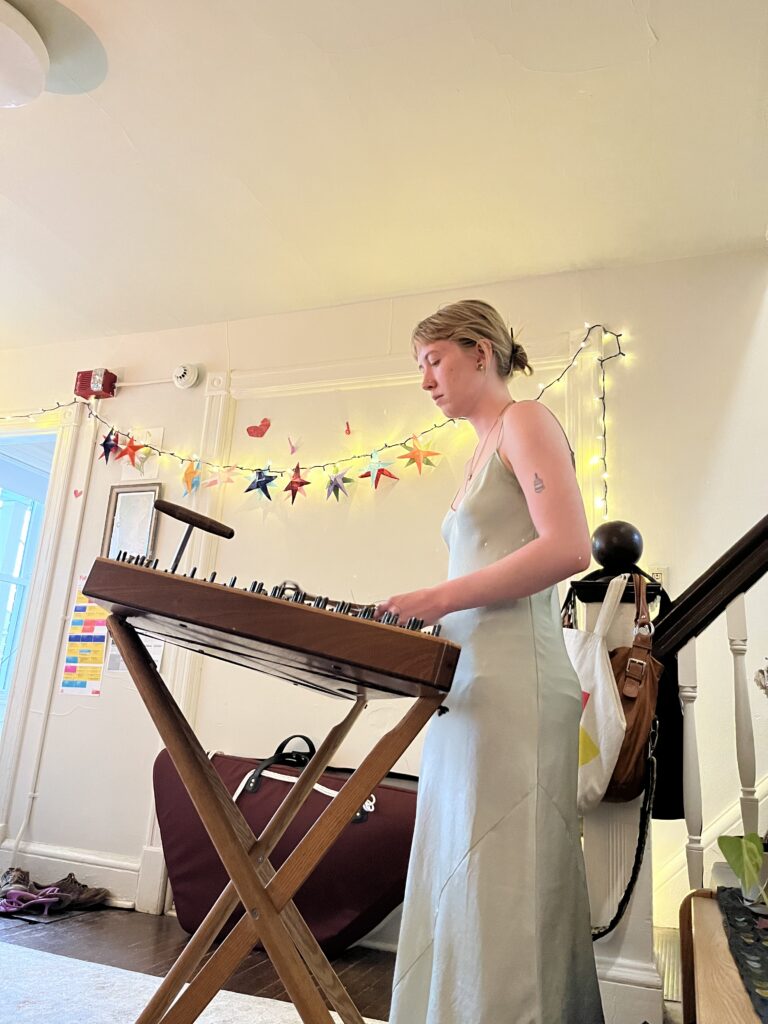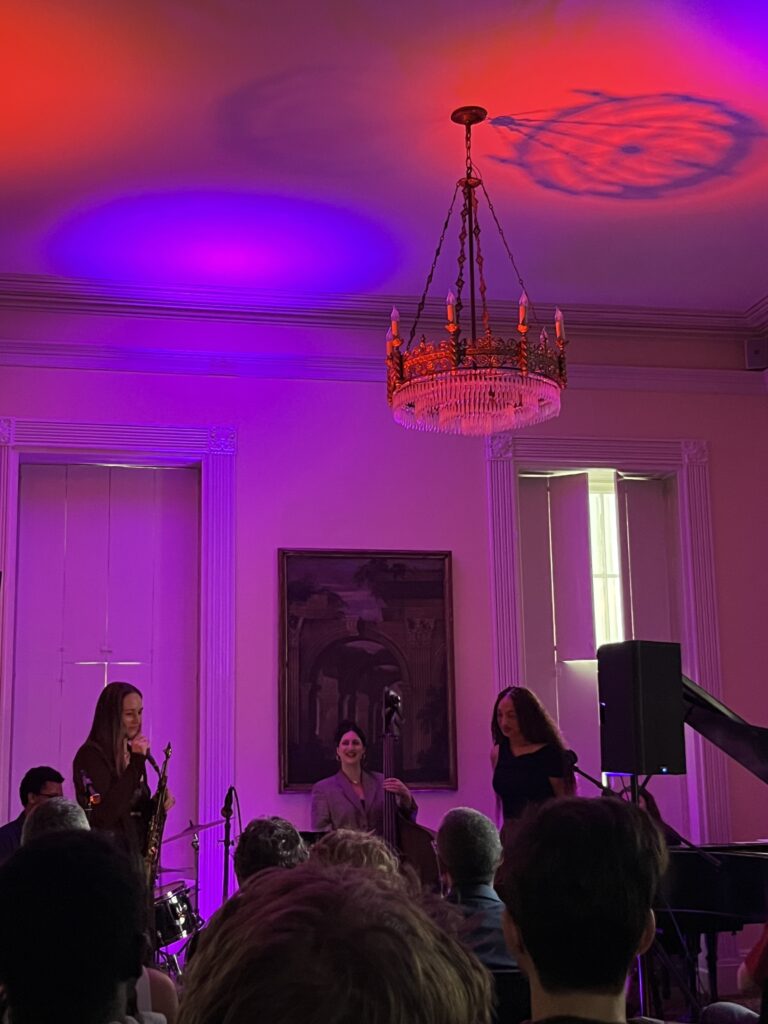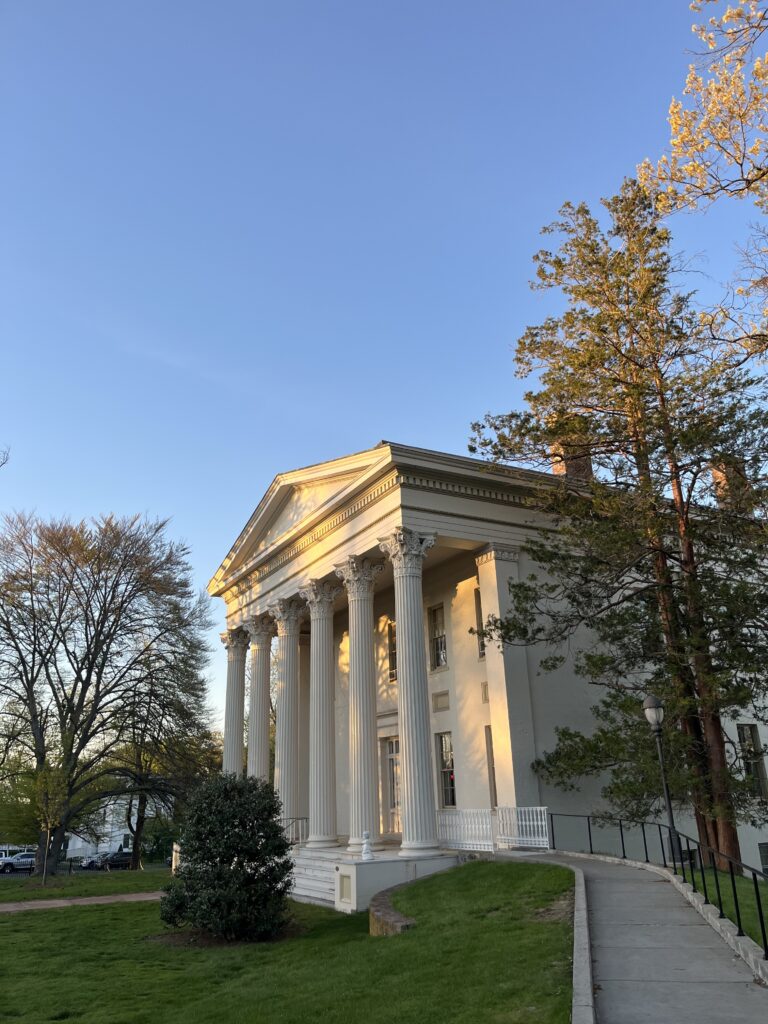This project was initially inspired by my process of learning the fiddle this semester and reconnecting with music. Over the semester, it evolved to include a much wider range of music that I was participating in and hearing. This was the first time that I worked with sound as a medium, and I found that I moved through my days differently when I was tuned into my sense of hearing. I was very curious about how music creates community within the musicians and within the audience. At the beginning of a performance, the audience might be a room full of strangers, but during the music, everyone is united in a shared experience. I was also thinking a lot about curiosity, wonder, and surprise. My curiosity brought me to a jazz concert with Roxy Coss, Tahira Clayton, Caili O’Doherty, Adi Meyerson, and Cory Cox performing at an event titled The Future of Jazz – The Future of Jazz is Female. During this performance, I was struck with the fascinating nature of jazz music. I was interested in improvisation, the chemistry of the musicians, the role of the female jazz performer as musician/activist, and the way that music is a gateway to new and awe-filled experiences. Lastly, I intend this project to serve as a sense archive of my semester through sound. I hope that you enjoy!
In Spring of 2024, I joined an informational Zoom call about the Contemplative Semester, a semester long program to study Buddhist philosophy, practice meditation, earth connection, and build community. The program was located on Potash Hill campus in Marlboro, Vermont. The Potash Hill campus was also the site of Boston States Fiddle Camp, which would bring upwards of 100 fiddlers and musicians to campus in October. When I decided to participate in the program, I was looking forward to the fiddlers’ arrival. Finally, the weekend came in late October. The fiddlers descended onto our campus. Late into the night, I would sit outside the practice rooms and hear people playing jam sessions. On the last day of the camp, the fiddle teachers played a concert for the students.
This clip is three friends playing together. They all live in different places, and were overjoyed to reunite at this event. Their enthusiasm was tangible in the music that they played. In this clip, you can hear people in the audience whooping and cheering. This moment felt so alive and the energy from the musicians radiated out through the audience.
Inspired by the fiddle concert, I signed up to to take fiddle lessons this semester! I had played classical violin as a kid, but it had been 5 years since I had picked up my instrument. I worked with a teacher named Craig Edwards, who met with me weekly. I primarily learned fiddle songs in the old-time fiddle style with a few Cajun songs and a Scottish air as well. I was inspired to learn the fiddle because of how lively, fun, and joyful the music is. I also was drawn to the community that is inherent in playing folk music.
Polly Put the Kettle On
Polly Put the Kettle On was one of the first songs that I learned how to play with my fiddle teacher this semester. This clip begins with me practicing the song alone, and then transitions to me playing together with my teacher at the end of the semester. Playing with my teacher was one of the first times that I had every played music with someone else, and I saw how much the music came to life with two people playing.
Dulcimer
I was sitting in my classmate Emerson’s house for a tea party, and after everyone had eaten their cookies and had tea, Emerson brought her Dulcimer out. At first, you can hear that people are still chatting, but soon become quiet and intent on listening to the music. During the tea party, people were talking to each other in separated pairs, and everyone did not know each other in the space. Suddenly, once the music began, we were all a united body as we let the music wash over us. It was striking how Emerson was improvising. I could hear a flow emerging as the piece went on. The audience was on the edge of our seat as listeners, but the musician was navigating the music moment-to-moment as well.
Singing Group
My friend Lilia led a weekly song circle this semester. We would gather outdoors as the weather got warmer and Lilia would teach us songs in the round, different voice parts, and harmonies, which we would learn and then sing together. It was so special to witness people coming together to make music with just our voices.
I chose to intersperse the songs from the singing group and sounds I recorded on a hike at Chauncey peak. In this way, as we sing about the earth and the trees, our voices and the sounds of the earth become one.
Piano in Practice Room
I lie on the floor, knowing how many a-capella groups and solo pianists have traversed this scratchy carpet, but I don’t mind. It is good to be on the floor. The scraggly brown carpet is worn, but it doesn’t really have a scent. I try lying in many different angles, each a new auditory landscape. Near the wall, I have visual access to the pages of music. The notes run up and down the page as if a bunny rabbit was tracking mud across the white paper with little skips and jumps. Long smooth lines arc above the notes – I’m not quite sure what they mean. I can see Lucas’s fingers travel fast, moving seamlessly to keep up with his eyes reading the music as it flows. In one section, one finger on the left hand presses one key, up and down, up and down, keeping the rhythm. The right hand moves from lower keys to higher, playing chords. When it reaches the static finger, it skips right over and continues on its journey to higher notes, all the while the left hand steadily plugs away at that note.
When I do a 360° swivel on the staticy ground, my head lands underneath the piano. Here the sound washes over me like waves crashing over my head, but lucky for me, I am unscathed, and I have oxygen to breathe. I never noticed the way that the pedal is connected to a lever. I am curious what happens next, but the next mechanism is obscured into the inner workings of the music making machine. I see the yellow plastic tube that runs underneath the piano. It probably used to be clear. It is connected to a sensor, which is visible to an observer at any normal height, not only one lying underneath the instrument. All three of the lights illuminate at different frequencies. The green one is steady – the power is on. The yellow one is rapid, indicating that the piano is thirsty for distilled water to keep itself humid and content. The red one blinks too, urgently calling for attention. This one tells us that the pads which distribute the water to the piano are no longer doing their job properly. This is one parched piano.
We start off in a Bach piece, on the outside of the dusky blue book, it says “Konzert.” Lucas artfully stumbles his way through complex runs of many notes. I don’t know anything, but I like being in that state of mind. It’s a practice coming home to “I don’t know.” Not always an easy practice at that. I do know that I am safe. Knowing that I am safe, I can open to the generative quality of not-knowing. I am curious, but rather than intellectualizing my curiosity into key signatures, music theory, and understanding, I let the music find its way into my heart, and lower into my dantian, below my navel, where my energy resides.
I roll over and find my phone in a light blue otter-box case. Two black googly eyes look out at me from the backside of my phone. The light sensing beings are always watching. I am not interested in their services. When the screen lights up, I flip to my recent apps, and voice memos is the first on the list. I tap the red and white recording icon, and the app opens. I hit record, and quickly place my phone back on the ground. It is near the wall, where there are sound-proofing boards directly above it. I wonder about how the quality of the sounds will come across. From this angle, I can see the music and Lucas’s fingers, but now I have tunnel vision to hear how my phone is hearing.
I wrestle with my mind. Can I truly be present with this recording device? Is it unethical to record something before I have asked permission? How has my quality of experience changed once I know this moment can be replayed? I know that isolating sound is just one of the many elements that make this a grand experience. How could I ever express this with just one sense? I hit pause on the recording.
A few minutes go by, and I try to regain my full presence in the space. Should I move my phone underneath the piano and see if it sounds more immersive? I don’t want to distract Lucas. I feign grabbing a drink of water, and in the minor hubbub, I move my phone discreetly underneath the piano. I hit the red button – record.
He asks me to pick a number between 1 and 179. After page 179, the pieces get more challenging. Okay – 48. My street number at home. I consider that maybe this piece should feel like home. It doesn’t. I do feel a tear forming, or maybe that was just the sunscreen in my eye from earlier. Melodic minutes pass by. Pick another number, he requests. Okay – 125. I feel a sense of responsibility. I think about if he doesn’t like the pieces that I chose, or what if I don’t? Crunchy harmonies blend from minor to major and swirl in a soup of unintelligible fantastical mystery. My thoughts ride the trains of the musical moments, changing alongside the confusing rhythms that Chopin crafted two hundred years ago. My phone is still under the piano, recording. It gnaws at me, beginning as a hum, and transforming bigger and bigger. One piece finishes, and Lucas tries the E♭(flat) major piece. This page is earmarked, just another sign that this book is clearly well-loved. During this piece, I wonder “what about Debussy?”
Lucas closes the dull mustard cover of the Chopin book once he’s finished playing.
“I’ll play a Debussy that I know” he offers.
My hands shoot up in cheer and a soft “yeahhh” escapes my mouth. Before I can scoff at my silly hand-gesture, I am transported into a dream. I whirl down the cascades and ride the clouds floating me out into the expanse of the wide universe. Simultaneously everywhere all at once and exactly right here. Staring directly at a fluorescent light, dim, with metal caging over the length of the bulb. The gnawing is so loud that it breaks through the comfort of lying down. NO. I reach for my phone and hit pause on the recording. This is just for me. I want it to just happen once, to be preserved in the singularity of this experience.
Before the night is over, Lucas proposes a bit of improv, a meditative sound bath. Now you’re speaking my language. He invites me up to the piano bench, and asks if I want to bop around and hit some keys. He takes the lower half of the keyboard, and I am up in the ethereal range. I follow via sound, occasionally looking at where his fingers lie, trying to match mine to his. We create music. It doesn’t sound like a melody, but heck, neither did Chopin. I move out of my head and into my fingers, as I remember that it’s all okay. I think about fear. The moment I sat down on the piano bench, right before I pressed my fingers down, there was a huge what if. What if I never start playing? Leave it to the master. What if I looked my fear in the face and played anyway? And I did. Lucas sighs “I feel relaxed.” Not sure I can say the same, but I feel simultaneously grateful and proud. I am grateful that I could lie on the carpeted floor of this sound-proof basement room and hear Bach, Chopin, and one arabesque. There are worse places to spend an evening, I digress. I am proud of myself. The part of me that showed up today and the brave part that didn’t let a little fear stop me from hitting some keys. Just another Thursday night in Middletown, CT.
Kaval Sviri – Slavei
I sing in an Eastern European and Balkan singing group called Slavei. In Slavei, most of our music is considered folk music, so we learn it by ear. We learn different voice parts, and they get passed down through generations of Wesleyan students by shared recordings or by simply singing the parts together. This is our group learning the high part of Kaval Sviri, a Bulgarian folk song, and us finally getting the complex ending after many tries.
The Future of Jazz – The Future is Female – A Night of Live Music with WIJO (Women in Jazz Organization)
One of Caili’s Compositions
Conversation with Roxy Coss
I approached this conversation in the style of a story circle, which we learned about from Jessica Kahkoska. I went into the conversation with a few questions prepared, but then I felt out the natural flow of conversation once we had started. In contrast to my experience in the practice room’s with Lucas, I found that I was more at ease once I started recording our conversation. Even though I intended for the meeting to feel more like a conversation, rather than an interview, I noticed that Roxy took the lead on answering questions and guiding the conversation once I began recording.
I decided to include the full interview below, including my comments. In the process of creating this project, I worked with the Audacity audio-editing software. I had created a second version of the interview with specific clips that I had picked out interspersed with the jazz music from the concert, but as it goes, my work unfortunately did not save. Alas. So, I am including the full interview! I was initially unsure of including my own voice and personal comments, but I do believe that my words give context to my questions and the origins of my curiosity. I gained a lot of insight through this conversation, and learned a lot more about Roxy’s life, her music, jazz music as a whole, and what it means to be a woman in jazz. I hope that it is enlightening to anyone who listens.


